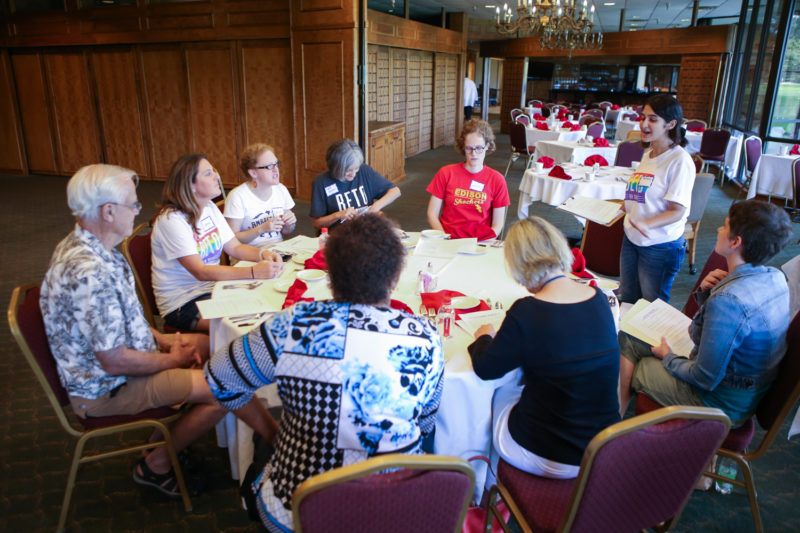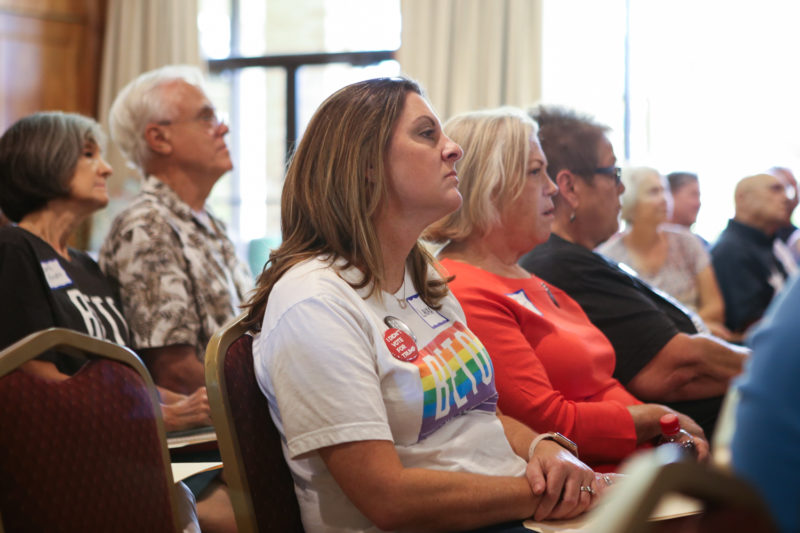In East Texas, O’Rourke Campaign Buoys Democrats’ Hopes
By VICKY CAMARILLO
Reporting Texas

A campaign worker for U.S. Senate candidate Beto O’Rourke speaks to volunteers at a country club in Lufkin, Texas, on Sept. 15, 2018. Vicky Camarillo/Reporting Texas
LUFKIN — In a normal year, a Democrat would have almost no chance of winning a statewide office in Texas. “But who here,” a campaign worker for U.S. Senate candidate Beto O’Rourke said to a few dozen people gathered in the East Texas city of Lufkin, “thinks this might not be a normal year?” Most of their hands shot up.
The Lufkinites had gathered at the Crown Colony Country Club on a sunny Saturday afternoon in September to take part in a volunteer training to get out the vote for O’Rourke. That effort consisted of going door to door, phone banking and creating pop-up campaign offices in the final weeks before the election.
The meeting was one of dozens that have happened throughout East Texas during the last year. The region’s 38 counties gave, on average, 80 percent of their votes to Donald Trump in 2016, but the ongoing litany of controversies surrounding him, political and personal, may have created an opening for Democratic nominees in the upcoming election, including O’Rourke.
Enthusiasm for O’Rourke is soaring among East Texas Democrats, and polls and national political observers say he has a chance. But to defeat incumbent Sen. Ted Cruz, he’ll have to succeed where East Texas Democrats have faltered in the recent past.
At the Lufkin rally, a campaign worker asked the crowd what had brought them out. One man said he and several members of the Latino community had attended a small breakfast with O’Rourke in nearby Nacogdoches a year ago, and he was struck by O’Rourke’s sincerity. “Beto was so honest and so real with each of those people and spent 15 minutes with each one, talking to them, hearing their story,” the man said.
Laura Bowman, a precinct chair for the Democratic Party of Angelina County, where Lufkin is the county seat, looked on from a seat near the middle of the room. Minutes before the rally began, Bowman’s voice shook with emotion as she spoke about her hope for O’Rourke and the future of Texas.
“This is a red state, but that’s because so many of us have given up because it’s been red for so long,” she said. “And then Beto comes out, and he’s just so determined, and even moderate Republicans and conservatives that are getting a little tired of the extreme right and the negativity [may vote for him],” she added.

Laura Bowman, a precinct chair for the Angelina County Democratic Party, looks on during a volunteer recruiting rally for U.S. Senate candidate Beto O’Rourke at a country club in Lufkin, Texas, on Sept. 15, 2018. Vicky Camarillo/Reporting Texas.
The Cook Political Report, a leading political newsletter, in September declared the O’Rourke-Cruz race a “toss-up,” a change from its previous “leans Republican” status. O’Rourke has trailed Cruz in polls by single digits since August, even surpassing him by 2 percentage points in a Reuters poll released in September.
Turnout in the 2018 Democratic U.S. Senate primary election in some of East Texas’ most populous counties — Jefferson, Smith, Gregg, Bowie and Angelina — jumped to more than 22,000 voters collectively from about 14,000 in the last midterm Democratic primary in 2014. The number of registered voters in those counties has also increased from about 447,000 in 2014 to almost 464,000 today. The increased primary turnout level indicates Democratic voters are uncommonly engaged, and many voters say it is because of O’Rourke.
About a dozen Democrats from those counties independently told Reporting Texas that O’Rourke is a unique candidate, that the fervor he has inspired is rare.
East Texas isn’t a huge portion of the state, but to win a statewide race, Democrats need to “return to marginally competitive status” in East Texas, said Mark Jones, a political science professor at Rice University.
O’Rourke’s rise has “provided ways for like-minded Democrats in East Texas to identify with each other in a way that hasn’t been the case since probably 2010 or 2008,” Jones said. “We didn’t realize how many Democrats are in East Texas until they started showing support for Beto.”
Jones said part of his appeal comes from his grassroots campaign — his tour through all 254 of Texas’ counties, his refusal to take PAC donations and his get-out-the-vote strategy — but it also helped that there was no fixed opinion of O’Rourke before his campaign began, as most of the state didn’t know who he was.
That contrasted with Democrat Wendy Davis’ bid for governor in 2014, after she’d made waves with her filibuster of an anti-abortion bill in the state Senate, and Hillary Clinton’s presidential campaign.
Davis was a “great candidate,” said James Cogar, chairman of the Gregg County Democratic Party, but she didn’t generate the kind of zeal he’s seen for O’Rourke.
“Is it all him? Is it leftover disappointment from Hillary losing the election two years ago? I’m not a sociologist. But this is very real,” Cogar said. “This is almost Obama[-level] enthusiasm.”
That kind of optimism was palpable during another organizing rally in Lufkin in July, before O’Rourke began to close the gap in polls and before he went viral online with videos of his trips to Whataburger and his impassioned defense of NFL players kneeling during the national anthem.
Tami Barugh, 57, had driven 70 miles from Houston County to Lufkin that day to be trained in block-walking. When asked about O’Rourke’s chances, Barugh said she was optimistic because of the number of Democrats she has met who are motivated to campaign for O’Rourke. Barugh said she has seen much less enthusiasm from Republicans in Houston County.
“There’s not a lot of push there like there’s been a lot of push for Beto,” she said.
On a humid evening in August, Hilda Sustaita, a precinct chair for the Angelina County Democratic Party, and Shirley Layton, a past county party chair who is running for the state Senate, went door to door in a low-income, predominantly black and Latino neighborhood in Lufkin. They’d been directed there by a voter database app called Voter Activation Network, which they used to target low-frequency Democratic voters, as well as anyone “that’s not a hardcore Republican,” Layton said.
Of the people who were home, all but two of the dozen or so residents didn’t know who O’Rourke is; one Latino man heard O’Rourke’s name and asked: Isn’t that the guy who sells properties near Nacogdoches?
But the women were heartened by the response from almost all of the residents, even those who weren’t familiar with O’Rourke: They planned to vote a straight Democratic ticket because it was time for a change in the country’s political landscape. “This is something I’ve never seen before in all my life,” the Latino man said of the Trump administration, “but I don’t know why nobody’s been doing something about it.”
Angelina County precinct chair Bowman said she’s seen O’Rourke’s name recognition grow in the area, and she’s still working to increase it and to encourage East Texans to vote.
“They’re seeing signs everywhere and they’re like, ‘Beto’s everywhere! He’s going to win, he’s going win!’” Bowman said. “We’re not there yet. At all.”
Even if O’Rourke loses, the energy and enthusiasm his campaign has generated makes Bowman optimistic for Democrats’ political future in the Lone Star State.
“Even if we wake up Nov. 7 and we’ve still got Cruz, we know that we can get there, because we’ve come a long way,” she said.